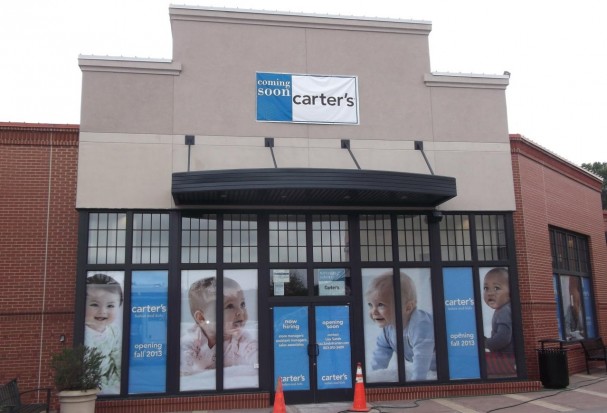 From the inside out, Jan Berte, owner of Legacy Graphics & Design, has found the ideal window graphics solution when Carter’s needs to hide the progress inside its stores as they’re being built or remodeled.
From the inside out, Jan Berte, owner of Legacy Graphics & Design, has found the ideal window graphics solution when Carter’s needs to hide the progress inside its stores as they’re being built or remodeled.
Carter’s specializes in clothing for babies and kids and has hundreds of stores across the U.S. in the process of being built or remodeled. Berte, based in Carroll, Iowa, says she’s been working with a store designer in Cleveland for the past dozen years to provide the graphics that both hide and promote.
 “We had been using adhesive vinyl, which was a nightmare from all sorts of angles, especially removal and the adhesive residue. Then we came up with the idea to use Tyvek. It’s recyclable, which is a big thing for me since the graphics are temporary and thrown away after they’re used. A note goes with every single panel to recycle the material when they remove it,” says Berte. “The graphics are all applied second-surface, inside the windows using LexJet Heavy Duty Banner Tape. There is very little adhesive removal – just a quick swipe with a razor blade and they’re done. Back before we discovered Tyvek, removal was more of a pain than the application.”
“We had been using adhesive vinyl, which was a nightmare from all sorts of angles, especially removal and the adhesive residue. Then we came up with the idea to use Tyvek. It’s recyclable, which is a big thing for me since the graphics are temporary and thrown away after they’re used. A note goes with every single panel to recycle the material when they remove it,” says Berte. “The graphics are all applied second-surface, inside the windows using LexJet Heavy Duty Banner Tape. There is very little adhesive removal – just a quick swipe with a razor blade and they’re done. Back before we discovered Tyvek, removal was more of a pain than the application.”
Berte uses LexJet TOUGHcoat 3R DuPont Tyvek and says it’s one of the most versatile print materials she’s found.
“LexJet Tyvek is so adaptable. You lay it flat for ten minutes and it stays flat. I’ve used it for permanent wallcoverings with wallpaper paste for Oshkosh stores. I wouldn’t have even attempted to use it for an indoor permanent wallcovering if it didn’t print great, because people see it up close and personal,” says Berte. “I love the way it prints; it prints beautifully. It has a good level of bright white, and the inks just pop on it. I print straight out of Corel right out of the box and I get excellent color results with it. Either the print gods smiled on me, or I just found a combination that works well.”
Berte prints the images that can range up to 80 inches wide and 9 feet tall on an Epson Stylus Pro 9890. The prints are paneled according to the size of the windows and marked on the back in order so the installers simply place the panels in the windows according to the directions.
“I create an image the size of the window and then print it in panels to accommodate either 36″ or 42″ material. I use a function within Corel to create the individual panels, usually with about a half-inch overlap for fudge factor. The two pieces of the image are exactly the size they need it to be for whatever window. If the installers are really ambitious they can go outside and look at it to make sure,” laughs Berte. “Even if I had a wider printer I’d split them anyway just from a shipping and handling standpoint. I almost always put them inside a plastic sleeve, then in the carton. With the handling and mishandling I don’t want them to get scratched or dirty during the shipping process.”
